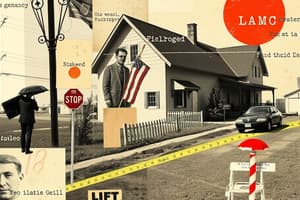Podcast
Questions and Answers
What is the 'code of the street' primarily concerned with?
What is the 'code of the street' primarily concerned with?
- Economic development and job creation.
- Educational reform and academic achievement.
- Informal rules governing behavior, especially violence and respect. (correct)
- Political activism and community organizing.
In the context of the 'code of the street', inner-city residents are often categorized into what two groups?
In the context of the 'code of the street', inner-city residents are often categorized into what two groups?
- Employed and unemployed.
- Educated and uneducated.
- Rich and poor.
- Decent and street. (correct)
What is a key characteristic of 'decent' individuals in inner-city communities?
What is a key characteristic of 'decent' individuals in inner-city communities?
- Involvement in criminal activities.
- Constant need to display toughness.
- Disregard for authority.
- Respect for authority, property, and neighbors. (correct)
What is 'street credibility' primarily associated with in the context of the 'code of the street'?
What is 'street credibility' primarily associated with in the context of the 'code of the street'?
What often drives young people to become involved in the drug trade in inner-city communities?
What often drives young people to become involved in the drug trade in inner-city communities?
What behavior do individuals in 'street' settings exhibit?
What behavior do individuals in 'street' settings exhibit?
What is the primary consequence of the need to maintain 'street credibility'?
What is the primary consequence of the need to maintain 'street credibility'?
What is the main reason for the distrust of law enforcement in inner-city communities?
What is the main reason for the distrust of law enforcement in inner-city communities?
What is the result of inner-city residents feeling abandoned by wider society?
What is the result of inner-city residents feeling abandoned by wider society?
Which of the following contributes to violence in inner-city communities?
Which of the following contributes to violence in inner-city communities?
What behavior is associated with building 'street cred' in the drug trade?
What behavior is associated with building 'street cred' in the drug trade?
Which factor leads to a perpetual cycle of violence in inner-city areas?
Which factor leads to a perpetual cycle of violence in inner-city areas?
What is an effect of residents feeling like there are two systems of justice?
What is an effect of residents feeling like there are two systems of justice?
In the context of the content, what does 'wider society abdication' lead residents to believe?
In the context of the content, what does 'wider society abdication' lead residents to believe?
In communities governed by the 'code of the street', what is the result of feeling disrespected?
In communities governed by the 'code of the street', what is the result of feeling disrespected?
What is the primary goal when maintaining street credibility?
What is the primary goal when maintaining street credibility?
How is involvement in the drug trade linked to street credibility?
How is involvement in the drug trade linked to street credibility?
What is the main impact of a lack of formal support structures?
What is the main impact of a lack of formal support structures?
How do inner city residents generally view the two identified systems of justice?
How do inner city residents generally view the two identified systems of justice?
Adherence to which set of values characterizes 'decent' individuals?
Adherence to which set of values characterizes 'decent' individuals?
Flashcards
Code of the Street
Code of the Street
Informal rules governing behavior in distressed inner-city communities, especially regarding violence and respect.
"Decent" Individuals
"Decent" Individuals
Adhering to mainstream societal values, respecting authority, property, and neighbors.
"Street" Individuals
"Street" Individuals
Tend to disregard mainstream values, sometimes engaging in criminal behavior.
Code-Switching
Code-Switching
Signup and view all the flashcards
Two Systems of Justice
Two Systems of Justice
Signup and view all the flashcards
Abandonment by Wider Society
Abandonment by Wider Society
Signup and view all the flashcards
Street Credibility
Street Credibility
Signup and view all the flashcards
Maintaining Street Credibility
Maintaining Street Credibility
Signup and view all the flashcards
Drug Market
Drug Market
Signup and view all the flashcards
Violence from Drug Trade
Violence from Drug Trade
Signup and view all the flashcards
Cycle of Violence
Cycle of Violence
Signup and view all the flashcards
Study Notes
Code of the Street Overview
- The "code of the street" is a concept developed to explain how individuals navigate distressed inner-city communities.
- This code is a set of informal rules and expectations that govern behavior, particularly concerning violence and respect.
- It emerges in communities where residents feel abandoned by the wider society and its institutions, including law enforcement.
Decent vs. Street
- Residents of inner-city communities are often categorized into two groups: "decent" and "street."
- "Decent" individuals adhere to mainstream societal values, respecting authority, property, and neighbors.
- "Street" individuals tend to disregard these values and sometimes engage in criminal behavior, but this is based on stereotypes.
- The terms "decent" and "street" are evaluative labels used by community members themselves, to differentiate between each other.
- Individuals can code-switch, adapting their behavior to be "decent" in some situations and "street" in others, with people generally tending towards predominately one or the other.
Wider Society Abdication and Street Credibility
- Many inner-city residents believe there are two systems of justice, one for white people and one for black people, leading to distrust of law enforcement.
- The feeling of abandonment by the wider society leads people to believe they must fend for themselves.
- "Street credibility" (street cred) becomes essential for safety; signaling a willingness to respond to disrespect and defend oneself.
- Maintaining street credibility is a constant performance, requiring actions that reinforce one's reputation for toughness and willingness to retaliate. This is why violence is so common is these communities.
Drug Trade
- The drug market becomes a viable option for young people seeking to survive in the streets due to the perceived lack of opportunities and support from wider society.
- Involvement in the drug trade often leads to violence as individuals strive to protect their territory and build street credibility.
- The need to survive and build street cred in the absence of formal support structures contributes to a cycle of violence and instability in these communities.
Studying That Suits You
Use AI to generate personalized quizzes and flashcards to suit your learning preferences.




